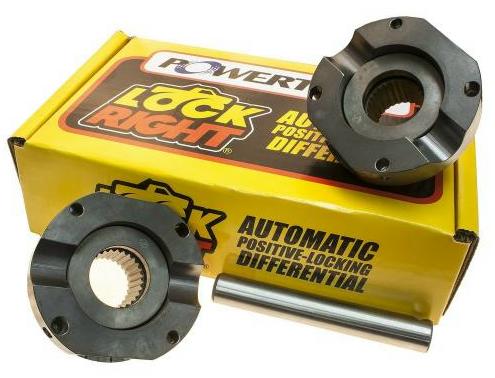By Will Wills
In the search for better offroad performance I am doing just about everything I can think of to make my truck unstoppable: everything short of Caterpiller tracks that is. I put in a more flexible suspension, bigger tires with aggressive tread and a locking differential in the rear axle. Finally, since it was cheap, and advertised as easy to install, I could not resist trying out a front locker as well. In the following article I will walk you though the installation of the Powertrax Lock-Right in the Dana 35. The main drawback of the differential is the crummy instruction booklet they include with it. Because it has dark, poorly photocopied black and white photos in it, if you intend to install one of these lockers you may want to print a copy of this article out to help guide you through it.
First, put the truck up on stands. The passenger side should be supported under the axle beam and the driver’s side under the frame to allow the driver’s side axle beam to hang down well below the passenger beam. This will assist in getting the differential out.
With the truck securely supported, remove the wheels, lock-outs, retaining ring, axle spacer, outer wheel-bearing lock-nut, lock washer and wheel bearing adjuster nut. Now slide the hub and disk assembly off of the spindle being careful to catch the outer wheel bearing. Set the bearings and hubs aside to be cleaned and packed if they haven’t been recently serviced.
Now you will be looking at five nuts per side that hold the spindle onto the knuckle. Remove these nuts and then bump the spindles off. One side of mine always comes off easily but the other I have to work off with a heavy, soft hammer.
After the spindles are out of the way, look behind the passenger side axle beam and find the rubber boot that protects the slip joint. With a pair of diagonal cutters, remove the inner Keystone clamp and discard it. You can now separate the axle shaft at the slip joint and pull the outer half out and set it aside. Moving around to the driver’s side, pull the left axle out and set it aside too.
Now, if you have stock radius arms on your truck you are going to have some trouble getting the differential out of the left axle beam. There is a long, vertical bolt on the left side of the differential that has to come out in order to remove the differential. The stock radius arm covers that bolt so it must be loosened and swung out of the way. My Duff radius arms are made with a big clearance around the bolt so it is no problem.
To loosen the radius arm, you have to remove the coil in order to get at the top radius arm bolt. That bolt is actually a stud that is too long for a deep socket so you will need a box-end wrench and a big extension in order to loosen it. Then loosen the bottom radius arm bolt with a long breaker bar and a huge cheater pipe. My ½” drive impact has proven way too weak to break this loose, so expect to work here. Lot’s of heat works too, if you have it available. Next, put a floor jack under the left axle beam and remove the nut at the end of the radius arm, then remove the nut and bolt that hinge the axle beam through the axle pivot bracket. You are going to be removing the axle beam from the truck because I have been unable to pull the radius arm out of the bracket in the past without pulling the axle beam free of the pivot bracket. After you get the beam on the floor, you can swing the radius arm out of the way and get the vertical bolt and nut out of the differential. I did not put mine back on; you don’t need it.
Working from the front of the truck, remove the circle of bolts holding the differential to the axle beam. After the bolts are out get a big pan ready to catch the oil from the differential. There is no drain hole so you have to be ready to cover a fairly wide area with your pan. Now grab a solid bar, maybe 18″ long and carefully pry the differential to pop it free of the beam. It is glued on there with silicon so it won’t come free all at once. Once you have a side loose, catch the oil and let it drain.
At this point it pays to have the differential beam hanging down past the right axle beam bracket. To get the differential out, pull it straight back until the housing is free of the pinch bolt bracket on the left, and then bring it out stub shaft side first. It is tight, but it does come. If you have trouble getting the differential out, try unhooking the sway control bar if the right beam is supported on a stand. You might also try disconnecting the left shock absorber or even loosening the coil spring nut from the bottom center of the spring. It might also be necessary to loosen the nut on the rear end of the left radius arm if it is binding the beam.
Now, with the differential out of the truck, clamp it vertically by the yoke in a big vise and remove the E-clip that holds the stub axle to its respective side gear. The E-clip won’t be going back in.
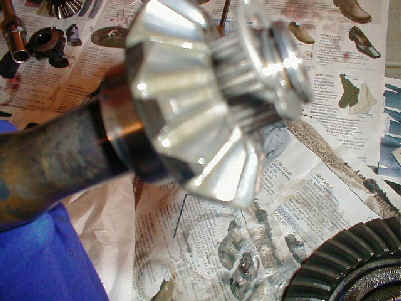
Remove the bolts that hold the bearing caps into the housing and remove the caps. Gently, and evenly, lift the carrier out of the differential housing. Be careful to keep the cast iron spacers and the bearing races from falling when you lift it out. Also, make sure these parts get back where they came from. Thoroughly clean the inside of the housing while you are looking at it.
Set the carrier on a clean surface with the ring gear end down. Locate the spring pin that holds the cross shaft (that big chrome shaft running through the carrier) and find a punch a wee bit smaller than that spring pin. Now turn the carrier over and drive the spring pin clear out of the carrier. You might need a long Philips screwdriver to finish pushing it out if your punch isn’t long enough. When the spring pin is free, flip the carrier so the ring gear is down again.
With your fingers push the cross shaft out of the carrier. If your cross shaft has flat sides you will need a new one. A new one may be included in your kit.
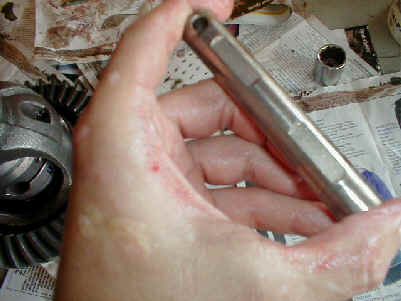
Now go through your kit and see what you have. The Dana 35 Lock-Right comes with the following parts: 2 drivers (the biggest pieces in the box), 2 couplers (they have splines cut inside of them), 2 spacers (the larger of the remaining parts) and 2 washers (they almost look like washers). There is also a small bag with 8 springs (4 larger and 4 smaller) and 4 little pins. Hopefully, you will find a cross shaft if yours has flats on it. Call the 800 number in the booklet and order one ($25) if you need it.
Grab a can of wheel bearing grease and put a thin but substantial coat of grease on every part in the kit. You need it all to stick together when you are assembling it. With everything greased, put the washers and spacers together to form one piece and then stick them inside of the drivers with the washer’s lip facing toward the teeth.
Next, put the little springs inside of the big springs and set them all off to the side.
Turning back to the differential carrier, reach your fingers in through the sides and rotate the pinion gears 90 degrees until they are accessible through the big openings. Pull them out of the carrier and set them aside. They won’t be going back in.
Next, pull the side gears (they have splines in them) out one at a time. As you pull a side gear out make sure you find the thin thrust washer and remove it.
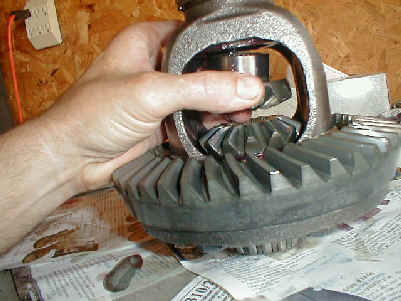
Stick it onto the back of a coupler (they also have splines in them and in fact replace the side gears) and put it into the carrier exactly how the side gear came out. When one side is done, do the other.
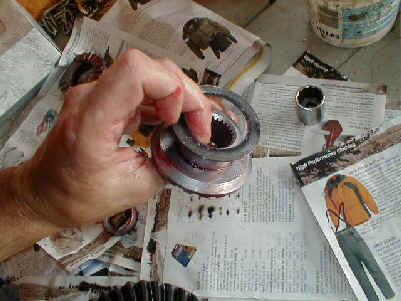
Now, look at the drivers. On the face of each driver (opposite of the splined surface) there are 4 holes. Two of the holes are oval shaped. Take a pin and push them into the oval holes until they are at least flush. Two pins go into each driver.
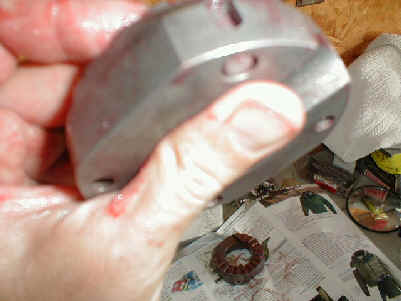
Now, holding one driver with its washer and spacer held with grease in its bore, press the teeth of the driver into the teeth of the bottom-most coupler.
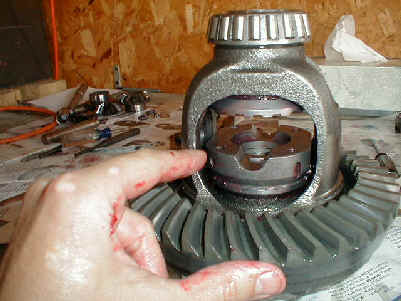
Now press the other driver assembly into the top-most coupler. The grease will hold it in place.
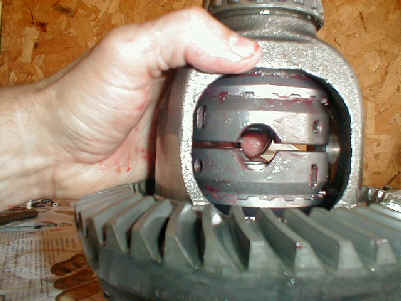
Turn the drivers so that a round window on one of them is paired up with an oval window on the other. All of the oval windows should still have pins showing in them. With a small screwdriver push each pin from its oval window into the round window in the opposite coupler. This will leave the oval windows open for the springs to be installed. Once all four pins are pushed into the round windows, insert the assembled springs into the oval windows. Use a screwdriver to gently compress the springs and then snap them into the windows. Double check them all to make sure they are solidly in there.
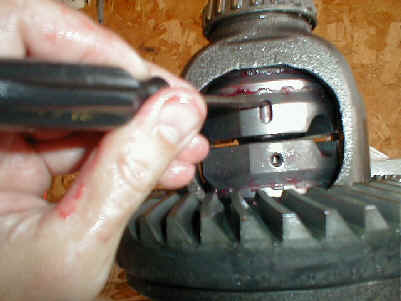
Now, turn the drivers so that the cross-shaft hole is lined up with the corresponding holes in the carrier and push the cross-shaft through making sure the spring-pin hole in the carrier lines up with the hole in the cross-shaft. Drive the spring-pin into the hole until it is just below flush. Take a small chisel and gently peen the carrier so a small amount of the iron protrudes over the hole and keeps the pin from coming out.
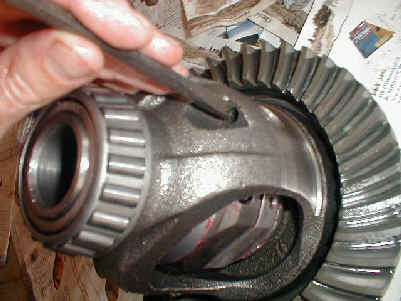
Now carefully set the carrier back into the differential housing making sure the washers go back in exactly as they came out. Letters marked on the housing and on the bearing caps show which cap goes on which side. Torque the caps to 47-67 ft# and you are ready to pop the differential back into the housing.
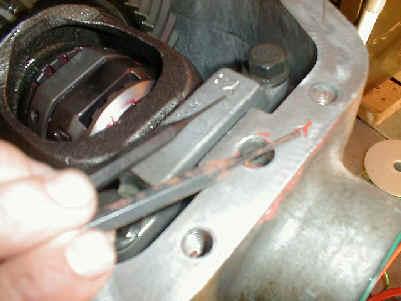
Putting the diff back in is a lot easier because the right inner axle shaft is not sticking out there and banging on the axle beam. Put a quarter-inch wide by eighth-inch high bead of gasket maker around the diff making sure to circle the holes and then push it up in there. The bracket on the left side of the housing will hold it while you get the bolts started. Run the bolts in snug and then torque them to 35-53 ft#.
Putting the right front axle back together is going to be different then taking it apart because we left out the E-clip and we need to put a spring inside of the slip-joint to hold the axle splines into the differential coupler.
Head down to the hardware store and paw through their spring assortment. You need a spring that is around an inch in diameter. You will end up cutting the spring downto approximately one inch in length. I say approximately because if your axle beams are not level you may need it to be slightly longer. The goal is to have about a quarter-inch gap in which to compress the spring between the spindle and the knuckle when the axles are assembled. This is enough pressure to keep the splines engaged in the coupler at any attitude the front suspension might encounter.
There is no design feature in the axle set-up that helps it deal with side loads so I do not recommend a heavier spring in the slip-joint. Nonetheless, it may make you feel better to weld the cap in a couple of spots to keep it from popping out into the yoke. I welded mine in two spots without taking out the U-joint.
Now, push the inner shaft into the differential, pop the spring into the yoke and assemble the rest of the front end in the usual manner. Don’t forget to orient the yoke ears on the right axle-shaft so they are in line with one another.
Once you have the truck back together, go and try it out. You can expect a little herky-jerky on tight turns as the axles take turns unlocking but the turning radius isn’t screwed up as it is with a welded front. Off-road the difference is quite noticeable, especially if you wheel in places that put your suspension to its limits or swim through mud holes. I have left my hubs locked in by accident before and I really couldn’t tell the locker was in there in 2wd on the street. Overall, this is a simple modification, fairly inexpensive and the results are pretty remarkable if you are a serious ’wheeler.

